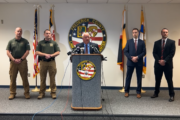“Christopher, you had a very serious accident. You’ll be on a ventilator the rest of your life and never move again.”
These were the words from my orthopedic surgeon as he quickly exited the hospital room. One tear rolled down my cheek, and for some reason those words never really sunk in — yet I’ll never forget them. I was stationed in Hawaii during my time in the Air Force, and I had broken my neck while doing front flips into the ocean. I landed on my head instead of my feet, and broke my fourth cervical vertebrae — which bent my spinal cord almost 90 degrees. Fortunately, I floated face up, but my friends couldn’t hear me yelling until the waves washed me closer to shore. I laid on the beach for an hour and a half, in and out of shock, before the ambulance arrived. Next thing I remember was waking up to my parents looking down on me. Tears of joy came over me; I had never been so happy to see them in my entire life. They had received a call at midnight, and my mom was told: “Hurry, we’re not sure he’ll make it by the time you get here.” With the help of my sister, they made a 14-hour trip within 24 hours of getting the call about my injury.
So there I was, bed-bound, intubated and paralyzed from the shoulders down. “Why me?” I never took life for granted, I was thankful for my abilities and appreciative of what God had given me in 22 short years of life. It’s hard to come to terms with such a life-changing event. I lost 100 percent of my independence and bodily functions in a split second. But the sooner you learn to accept it, the sooner you can move on to a path of some sort of recovery. So, this is my journey.
Before surgery could take place, doctors had to realign my spine. This was accomplished using a halo (a medical device that screws into the skull at four different locations), which had 40 pounds of weight attached to it. After three tortuous days of halo adjustments straightened my spine, I was ready for surgery. Bone was taken from my hip to reconstruct the fourth cervical vertebrae. Then, wire was wrapped around the fourth and fifth vertebrae to fuse them together. I sported a hard, plastic cervical collar as my “bling” for the next six weeks to limit my head movement and enable the two vertebrae to calcify. I hated that thing — I would get so itchy. I couldn’t scratch myself, and the difficulties I had communicating drove me absolutely nuts. Surgery was a success but I was still in critical condition. Having ingested so much saltwater caused pneumonia and kept the medical staff from attempting to wean me off the ventilator. After 11 days at Tripler Army Medical Center, a decision was made to transfer me to Louis Stokes Cleveland Veterans Affairs Medical Center. Besides being 30 minutes from my hometown, the Cleveland VA is known for its spinal cord injury unit.
[See: 8 Health Technologies to Watch For.]
After departing Hawaii, my next destination was an overnight stay at Travis Air Force Base in California. I was supposed to arrive in Cleveland the next day. Well, four stops later I found myself spending the night at Scott Air Force Base in Illinois. I was in critical condition, traveling with a doctor and respiratory therapist, and it should have been a one-day trip. My mom had such a bad ear infection that doctors tried to keep her from flying with me. Finally, two days after leaving Hawaii, I arrived in Cleveland. I was immediately placed in the intensive care unit, and respiratory therapists began the process of weaning me off the ventilator. Hands-down this was the hardest thing I’ve ever experienced in my life. Every second of every minute of every hour, I felt as if I were suffocating. As long as my oxygen saturation stayed 90 percent or above, respiratory therapy would continue to decrease the breaths per minute I received from the ventilator. It took nearly one month, but I was finally able to breathe on my own, something the doctor in Hawaii said would never happen.
Finally stabilized, I was transferred to the spinal cord injury unit for rehabilitation. Setbacks were plentiful, beginning with uncontrollable fevers caused by damage to the central nervous system. It was common for me to have a temperatures of 103 degrees Fahrenheit, and a chilling blanket was used to control my temperature. Fevers of that magnitude had always given me chills, and I’ve never been so cold as I was on that blanket. Then there’s pressure sores. I had just started getting up in a wheelchair and was hopeful to start therapy, but a wound on my sacrum (the area right above the butt crack commonly referred to as the tailbone) opened up, putting me in bed for six weeks. It was during that time when movement slowly returned to me. I was first able to supinate my left arm (in other words, rotate the hand to a palms-up position), and then did the same with the right arm. Bicep function and wrist extension came next. As the swelling in my spinal cord decreased, these movements returned and got stronger. By the time my wound healed, I had enough strength in my right arm to operate a power wheelchair. During the week, much of my time was spent working with weights, often twice a day. In just four short months after my injury, I had enough strength in my arms to push a manual chair (which is slightly faster than a turtle’s pace and was a great accomplishment for me).
[See: 8 Cool Uses for 3-D Printers in Health Care.]
I spent a total of 10 months at the VA Medical Center before being discharged. During that time, I met the most wonderful, knowledgeable occupational therapist. She offered me an opportunity to participate in a study that involved the implantation of electrodes to restore hand function, which is referred to as functional electrical stimulation or FES. In January 1995, I had surgery to implant a small device under my left pectoral muscle. Branching off this are wires with electrodes attached at the ends. Routed under the armpit and down the arm, electrodes stimulate different nerves and muscles that control the hand. I was the 10th in the state of Ohio and the 23rd in the world to receive this technology; without it, I’m unable to grip anything on my own. It’s hard to explain how restoring this little bit of function has made such a huge difference in my life. Freedom from reliance on prosthetic devices has given me a sense of normalcy and leaves me less reliant on others. Additionally, I’ve met an abundance of people whom I consider to be the brightest, most caring individuals in the medical field. They have been instrumental in my recovery and have given me opportunities that have increased my quality of life in so many ways. I’m forever grateful.
After discharge from the VA, I moved in with my parents. Being back at home was a constant reminder of my pre-injury life and all the memories of my upbringing. That was just one of many things that made it difficult adjusting to my injury. Gone were the days of spontaneity; now every day begins with a routine. Wake up in the morning, take pills, empty my bladder (a medical procedure known as intermittent catheterization, which needs to be done every 4 to 6 hours), do range of motion on my legs (a series of stretches to prevent muscle contractures and reduce spasticity), then get washed up, dressed and in my chair. As a result of damage to the spinal cord, bowel function is also compromised. Every other day, a bowel routine is performed. This entails the insertion of a rectal suppository that stimulates the colon, which in turn evacuates stool. As you can probably imagine, this routine, along with the inability to do all the things that I once enjoyed, is a hard pill to swallow. Lucky for me, I’ve got a great support system and a twisted sense of humor, both of which were necessary for me to keep moving forward.
In 1995, I built a house utilizing resources that were available to me from the Veterans Administration. My sister, brother-in-law and niece moved in with me when it was completed. My sister was my primary caregiver until I set up services with a home health care agency. Life was coming together. I started taking some college classes, though I had no career goal in mind. It was good for me to get out and be around other people, though I was still very self-conscious about being in a wheelchair. I liked to get out but was uncomfortable with myself and being around people who didn’t understand my injury.
In 1996, I met my sister’s girlfriend’s sister. We hit it off immediately and had a lot in common, and she enjoyed wheelchair rides. In August 1997, we tied the knot. I was blown away when several of my friends from Hawaii flew in to attend the ceremony — it was the best wedding gift ever. As time passed, I continued to reach new milestones. I took drivers training classes, got my license and started driving. Three years into marriage, my wife and I decided to have a child. We needed to use in vitro fertilization because of my injury, and three embryos were implanted. In August 2001, we had a 9 lbs. 1 oz. baby boy. The highlight of that whole day, besides the delivery of a healthy baby, was the fact that I, husband and now father, had the privilege and ability to drive my wife to the hospital to deliver.
[See: In Vitro Fertilization Grows Up.]
Unfortunately, complications developed in the marriage, and we divorced shortly before my son’s second birthday. Because of circumstances surrounding the divorce, I was named the residential parent. With the help of my mom (who moved in with me Monday through Friday) and dad, I was blessed with the opportunity to raise my son. Because I didn’t work, all my time was able to be spent with him. Initially I had reservations about parenting from a wheelchair. I thought of all the things I wouldn’t be able to do with him as a father — but it turned out I could do a whole lot more than I thought. Because I had to explain everything, he takes verbal instruction very well and has become very self-reliant because I couldn’t do everything for him. Above all, I wanted him to be a hard-working, caring, compassionate individual.
When my son started school, I was offered an opportunity to participate in a VA study. It involved returning people with spinal cord injuries back to work. I had an idea to open up a spinal cord rehab facility and gym. With the help of some very special people, I wrote up a business plan that required approval on state and federal levels. It took four years from start to finish, but in September 2011, Buckeye Wellness Center opened its doors. The only facility of its kind in Ohio, it offers people with spinal cord injuries and other disabilities a second chance to reach their therapy goals when insurance stops paying. There’s also accessible gym equipment so people who want to stay in shape can exercise. (It’s worth noting that I remarried in 2004 to my wonderful wife, Susan, and she’s been instrumental in raising my son. Buckeye Wellness Center wouldn’t exist without her, either.)
It’s been over 23 years since that tragic day on the beach. I often wonder what I would’ve done with my life had I not broken my neck. The doctor in Hawaii who did my surgery told my mom I would curse the day he saved my life. I’d actually like to thank him. I’ve been blessed in so many ways since that day — my life would not have been nearly as fulfilling had it not happened.
More from U.S. News
8 Lesser-Known Ways to Ruin Your Joints
10 Ways to Prepare for Surgery
I Was Paralyzed By a Spinal Cord Injury — and It’s Made My Life More Fulfilling originally appeared on usnews.com







